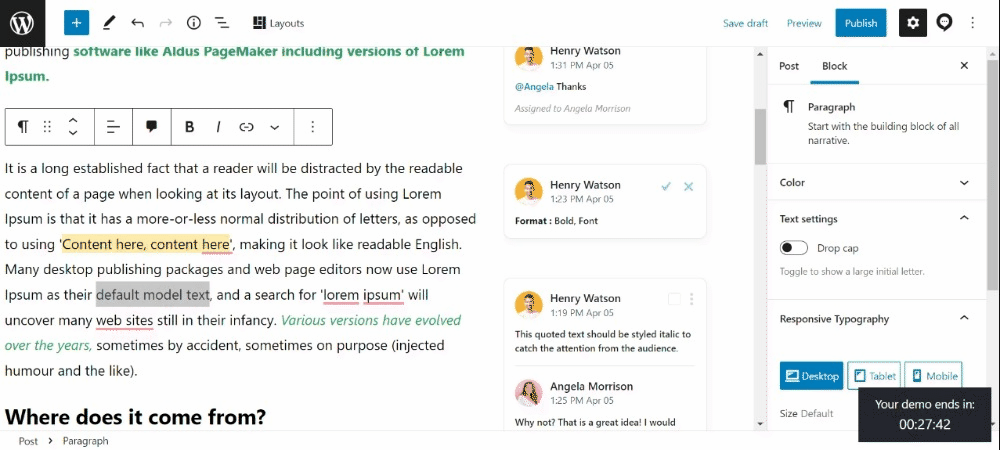Table of Contents
A content marketing workflow allows teams to ideate, draft, publish, and promote quality content effectively. It is a documented process that helps:
- Ensure that the content creation process is consistent and effective
- Improve collaboration and communication between team members and external stakeholders
- Align the content with the brand’s objectives and the needs of the target audience
- Avoid confusion and delays by clarifying tasks and responsibilities for everyone
- Track the performance of various content pieces and find areas of improvement
Keep reading to learn how you can create and implement a customized content marketing workflow for your WordPress team.
How to create a successful content marketing strategy?
Creating a successful content marketing strategy involves a systematic approach to aligning your content creation efforts with your overall business goals. Here’s a step-by-step guide to help you develop an effective content marketing strategy:
1. Determine your Goals
This is where you answer the question — why do we need a content marketing workflow?
Depending on your current business goals, it can be things like gaining organic visibility, educating your target audience, or getting more signups. Defining your goal(s) clearly will help you visualize the outcome and achieve it efficiently.
There are three major tasks you need to complete to finish this step:
- Find out your current business goals based on the industry you are in and the impact you aim to have in the lives of your customers.
- Determine how (and if) content marketing can achieve those goals.
- Identify the key metrics or performance indicators that you need to monitor to measure your progress and set benchmarks for them.
WordPress content teams must assess their resources before setting goals, as this is the foundational step in building a content marketing workflow. For instance, trying to keep up with large enterprises might be an unrealistic expectation from the content marketing workflow of a small team.
2. Find what your Audience Wants
As we mentioned briefly earlier, your content marketing strategy should be centred around your target audience because they are the ones who you will be creating content for. This step aims to determine what kind of content your audience wants in terms of topic and format.

Use these three tips to get started:
- Conduct surveys, polls, and interviews to learn what your audience would like to see/learn
- Monitor social media, online communities, and forums to gain a deeper understanding of their pain points
- Analyze your existing content’s performance (both on the website and social media) to find out which ones are popular among your audience
It is recommended that you start with low/no-cost steps, such as monitoring your website’s analytics to learn about your target audience and move from there. You can also offer freebies and coupons to your audience to increase survey response rates.
3. Develop a Content Calendar
Utilizing social media accounts and organic traffic is integral to boosting brand awareness. Incorporate a social media strategy that aligns with your content marketing strategies, incorporating user-generated content and visual content to maximize impact.
Develop a well-thought-out editorial calendar to guide your content creation process and maintain a consistent online presence. A content calendar contains the schedule for your content creation, publication, and promotion. The goal is to be a valuable resource for both existing customers and potential customers, positioning your brand as an authority in your industry.
You can create a content calendar in three easy steps:
- Determine the frequency of your content publication (daily, weekly, etc.)
- Assign tasks and responsibilities to your team members
- Modify the calendar as per your team’s feedback, business goals, and audience’s needs whenever necessary
While determining your content publication frequency, it is important to collaborate with your team members to avoid setting unrealistic deadlines for content delivery. It is even better to let your team set deadlines themselves as they will be running the content marketing workflow. Repurposing content across various channels, like email marketing or paid media, extends its reach and ensures a consistent flow of valuable resources for your audience.
Now that you have created a content marketing workflow, let’s look at how you can implement it to achieve your goals.
How to implement your content marketing workflow?
1. Define your content creation strategy
In this step, you answer questions like “who will be creating your content?”, “what are the steps from ideation to drafting?” and “How will the content pieces be created?”. The aim of this step is to define tangible and operational steps for your content marketing workflow.
Here’s how to go about it:
- Create guidelines for each type of content you want to publish to ensure uniformity
- Decide how you will create your content — in-house or outsourced to an agency
- Adopt the right task and project management tools to establish clarity among team members
One of the most crucial things you need to take care of at this stage is to encourage your team members to communicate overtly and participate in decision-making. This will lead to an efficient implementation of your content marketing workflow as the decisions are made by your team members themselves.
2. Track the performance of your content
You need to measure the success of your content marketing processes to find out what is working and what needs to change. This will allow you to scale up your efforts wisely and will give you a higher ROI for your efforts.
It is essential to develop an action plan before you start to track your content performance. For instance, if your audience prefers one topic over the other, you need to have a plan in place to produce more content in that domain.
A common mistake that your WordPress marketing team might make is to focus on vanity metrics rather than North Star metrics that actually reflect your business’ performance and customer satisfaction.
For example, if your North Star metric is the number of demo requests, focusing on metrics like traffic from social media can be unproductive. To avoid this, make a practice of choosing key performance metrics based on your business goals and customer satisfaction.
As you create processes and distribute content, monitor performance using tools like Google Trends and analytics. Adapt your strategies based on insights gained, optimizing for the highest impact.
3. Regularly update your marketing workflow
New technologies emerge, the needs of your audiences evolve, your team grows, and your business goals change. Sticking to a rigid content marketing workflow, regardless of how successful it was at a time, will prevent you from making consistent progress.
This is where retrospective meetings come in handy. Retrospective meetings compare your content marketing workflow’s periodic performance to discover new opportunities and identify areas for improvement.
Focus on quantitative elements, such as the key performance indicators, and qualitative elements, such as the alignment of the efforts of your team with the business goals. Then, collaborate with your team and stakeholders to make changes to your WordPress content marketing workflow.
Ultimately, a successful content marketing campaign is a holistic approach that combines organic and paid strategies, leverages various content formats, and addresses the diverse needs of your audience at different stages of their journey. By consistently providing valuable information, you not only increase brand awareness but also foster lasting relationships that translate into new customers and sustained growth.
Run your WordPress Content Marketing Workflow effectively with Multicollab
As we have mentioned a few times earlier, one of the most essential ingredients to create and implement a content marketing workflow is team collaboration. How well your team can communicate ideas, exchange feedback, and work together is pivotal to the success of your workflow.
It is vital, therefore, for content teams to equip their WordPress content teams with the right tools to facilitate qualitative collaboration. And this is where Multicollab comes in.
Multicollab is a WordPress collaboration plugin that enables Google Docs-style editorial commenting in the Gutenberg Editor. You can comment, suggest changes, and tag other team members just as you do with Google Docs:

Apart from moving your content approval and editorial process to WordPress, Multicollab also helps with:
- Sharing feedback on videos and dynamic content (image carousels, CTA blocks, etc.) as the Gutenberg Editor is a blog editor
- Protecting your organizational data as you won’t have to give unrestricted access to your company’s drives to external parties
- Managing permissions of internal and external collaborators through various phases of the content marketing workflow
… and much more.
Get started today – click the link to experience all Multicollab features with a 14-day free trial here.
FAQs:
1. What is a content marketing workflow?
A content marketing workflow is a systematic process that outlines the steps necessary for the creation, publication, and promotion of content that aligns with a business’s marketing objectives and target audience’s needs.
2. What are the seven steps of content marketing?
The seven steps of content marketing are defining goals, identifying the target audience, conducting research, developing a content strategy, creating the content, promoting the content, and measuring and optimizing results.
3. What are the five rules of content marketing?
The five rules of content marketing are understanding the target audience, providing valuable and relevant content, consistent publication, utilizing a variety of formats and channels, and measuring the success of the content.






